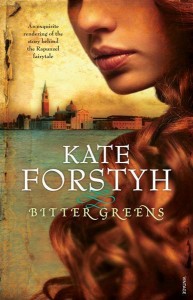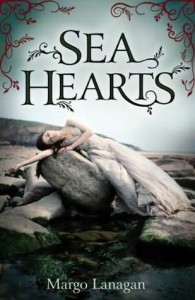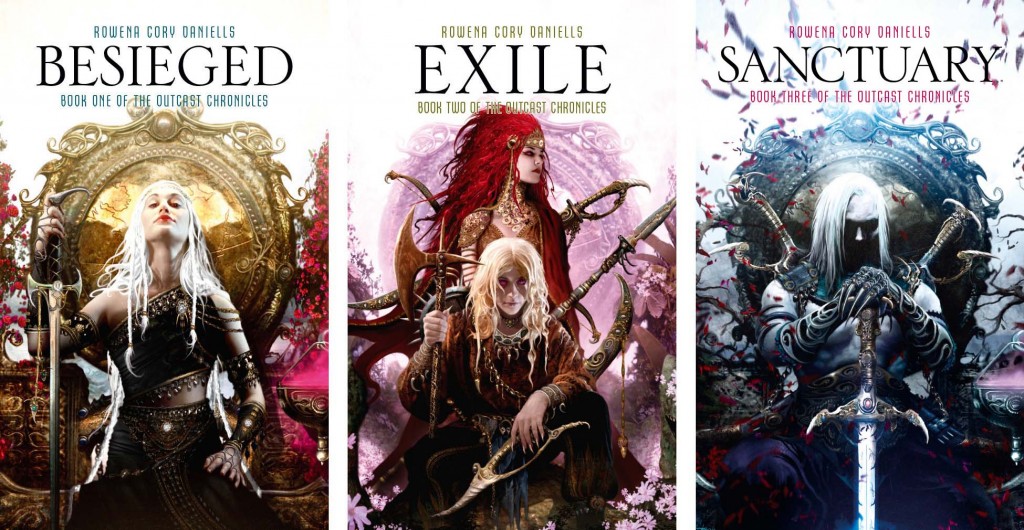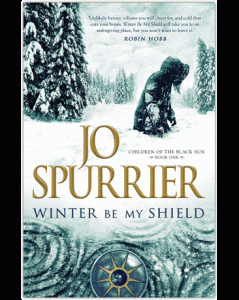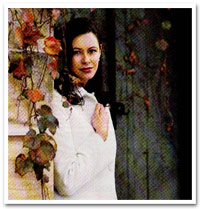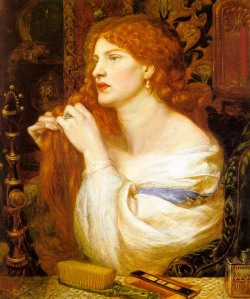As the next of my series featuring fantastic female fantasy authors (see disclaimer) I’ve invited the talented and always engaging Kate Forsyth to drop by.
Watch out for the give-away at the end of the interview.

Q: Kate, tell us a little about your new book?
The Starkin Crown is a fantasy adventure for readers aged 12 and above, which tells the story of Prince Peregrine, a boy who must overcome treachery, heartache and his own secret weakness in order to find the lost spear of the Storm King.
With the blood of wildkin, hearthkin and starkin in his veins, Peregrine is heir to both the Erlqueen of Stormlinn and the starkin throne – except that the starkin crown was seized before his birth by his grandfather’s cruel cousin Vernisha. An ancient prophecy says that Peregrine will be the one who will at last break the starkin’s ruthless reign and bring peace to the land, but his parents fear the prophecies and try to keep him safe.

The arrival of a starkin girl with an urgent warning of an impending attack sees Peregrine and his faithful squire Jack flee Stormlinn Castle. Guided by a mysterious white owl, and with enemies on all sides, Peregrine soon realises that there is a traitor in their party … and that he must learn to trust his own heart.
Q: Your first series was The Witches of Eileanan, which took its inspiration from the Scottish witch trials of the 16th century. There are six books in the series. You must feel like the world and characters are old friends. Are you tempted to revisit it with a new series?
I get emails every week begging me to write more books set in Eileanan, and I always reply, “Maybe one day”. With the six books of ‘The Witches of Eileanan’ and the three books in the ‘Rhiannon’s Ride’ series, the books set in Eileanan took me ten years to write and constitute more than a million words. I loved writing them and I’m glad so many people have enjoyed them, but I had so many other ideas I wanted to bring to life!
Q: There is also Rhiannon’s Ride Series, with a ‘fierce satyricorn’ heroine. It loo ks like it could be YA cross-over. What age group was this written for?
ks like it could be YA cross-over. What age group was this written for?
‘Rhiannon’s Ride’ is a series of three books set in the world of Eileanan sixteen years after the end of the last book in ‘The Witches of Eileanan’. I always say the Eileanan books can be read by anyone sixteen years and older – there’s lots of battle scenes, cruel betrayals, traitors, necromancy, torture, love, despair, and ultimate triumph – not reading for the faint of heart!
[youtube=http://www.youtube.com/watch?v=1DfrYkFMl7g&feature=player_embedded]
Q: The Chronicles of Estelliana (The Starthorn tree, The Wildkin Curse and The Starkin Crown is for ages 12 and up). I see there is a girl heroine again. Is this a theme you like to explore?
Actually, in the three books set in Estelliana I always have two boys and two girls around 15 years of age, and the primary protagonist is always a boy. This is because I wrote these books for my eldest son, Ben, who loves fantasy fiction. The books are read by both boys and girls – I try and have all four of my heroes being vivid, interesting, and fully realised characters with their own strengths and weakness, and their own lessons to be learnt.
Q: I remember you were so excited when your children’s series The Chain of Charms won the Aurealis Award for its section in 2007. That must have been a real buzz. This series is set in the time of Oliver Cromwell. Did you have to do a lot of research?
 It was wonderful! There are six books in ‘The Chain of Charms’ series, and five of them came out in 2007 so I was thrilled to have all five of them short-listed that year. You can imagine my excitement when all five of them ended up winning! It’s the first time that’s ever happened. And, yes, I had to do a great deal of research but then I do with every book I write. With the ‘Chain of Charms’ series, I read every book I could find on Oliver Cromwell and King Charles II, the English Civil War, life in the 17th century, and the language and culture of the Romanichal, or the English Gypsies. I also took my three children to England for a month, travelling in the footsteps of my two Gypsy children in their wild adventures in Kent, Surrey and Sussex. I even began to dress like a Gypsy, and Gypsy Stew became a favourite meal of our family.
It was wonderful! There are six books in ‘The Chain of Charms’ series, and five of them came out in 2007 so I was thrilled to have all five of them short-listed that year. You can imagine my excitement when all five of them ended up winning! It’s the first time that’s ever happened. And, yes, I had to do a great deal of research but then I do with every book I write. With the ‘Chain of Charms’ series, I read every book I could find on Oliver Cromwell and King Charles II, the English Civil War, life in the 17th century, and the language and culture of the Romanichal, or the English Gypsies. I also took my three children to England for a month, travelling in the footsteps of my two Gypsy children in their wild adventures in Kent, Surrey and Sussex. I even began to dress like a Gypsy, and Gypsy Stew became a favourite meal of our family.
Q: The Puzzle Ring was written for ages 10 and up. In this one you have a time travelling heroine who goes back to 16 century Scotland. Are you a big fan of Scottish history?
I was brought up on family stories about Scotland – my grandmother’s grandmother was Scottish on both my mother and my father’s side which meant as a child I heard many an old tale of bloody battles, murdered queens, fugitive princes, ancient curses, loch monsters, and one-eyed giants. I’ve always been interested in Scottish history and mythology as a result, and read a lot of books set in Scotland growing up. So when I was thinking about where to set ‘The Puzzle Ring’ –it seemed very right and natural that it should be set in Scotland and that I should draw upon some of the stories my grandmother and great-aunts told me.
 Q: Ben and Tim’s Magical Misadventures series looks like it is meant for a younger reader again. And then there is a picture book titled I Am. Your books range from picture books, through the different primary age groups, through Young Adult to the grown up books?
Q: Ben and Tim’s Magical Misadventures series looks like it is meant for a younger reader again. And then there is a picture book titled I Am. Your books range from picture books, through the different primary age groups, through Young Adult to the grown up books?
Do you have to get into a certain mindset to write for a certain age group?
I always say that you can read my books from birth to death! Basically, ‘I Am’ and the three Magical Misadventures were written for my own children’s reading pleasure and I was thrilled when they were published and other children loved them too. I never have any problem writing for different age groups – I always know exactly who my audience is before I even write a word. I ‘see’ the whole narrative shape in my mind’s eye, and know who I want to read it.
Q: You originally worked as a journalist. (See here for a series of articles on Kate’s web site).Did you enjoy this and was it a big leap to writing fantasy?
I always wanted to be a novelist – working as a journalist was a way to pay the bills until I was ‘discovered’. I still write half a dozen articles a year for various publications, for no other reason than my own pleasure. I love to write in many different shapes and forms –it’s challenging to conquer the different styles, and I feel small projects like poetry, articles, picture books, and early readers are a way of refreshing my mind in between the big, long, complex novels I usually write.
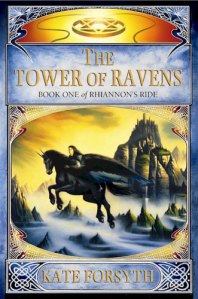 Q: My youngest son had a severe speech impediment. He didn’t have a recognisable (to others) word when he started school. I worked long and hard with him to help him overcome it. I believe you had a speech impediment as a child. Did you find the frustration of not being able to communicate your ideas shaped the person you are?
Q: My youngest son had a severe speech impediment. He didn’t have a recognisable (to others) word when he started school. I worked long and hard with him to help him overcome it. I believe you had a speech impediment as a child. Did you find the frustration of not being able to communicate your ideas shaped the person you are?
I had a severe stutter as a child, which meant many hours of speech therapy. My mother worked incredibly hard with me, just like you did with your son, to help me conquer my stutter. One of the things I was encouraged to do was read poetry and Shakespeare aloud, and I truly believe this had a profound effect on me, giving me a deep love of language and rhythm and rhyme. It also meant that I retreated into books, and read voraciously as a child, because I struggled to express myself at school and in unfamiliar situations. I still stutter when I’m tired or nervous or excited, but in general I think I’m quite fiercely articulate now and proud that I was able to overcome the great obstacle that was my stutter. (Read Kate’s article on stuttering).
Q: Tell us a little about the book you are working one now. Set in the time of Louis the 14th, involving a French noble woman, a young girl shut up in a tower, and a Venetian Courtesan, it sounds wonderful.
Thank you! I must admit it has been wonderful to write. Called ‘Bitter Greens’, it is a historical novel for adults which interweaves a retelling of the Rapunzel fairytale with the life of one of its first tellers, the scandalous 17th century French writer, Charlotte-Rose de Caumont de la Force. Charlotte-Rose shocked the court of the Sun King with her love affairs and her dabbling in witchcraft, and so was banished to a convent in the country. In those days, enclosure was very strict and so Charlotte-Rose would not have stepped outside the high, stone wall of the convent or seen anyone apart from the nuns and their lay-sisters. She wrote the fairy tale ‘Persinette’ while imprisoned, which was later renamed ‘Rapunzel’ and bowdlerised by the Grimm brothers. Her life story was a gift for a novelist – I could not have made up a better story! The novel is told in three strands – Charlotte-Rose’s life in Paris and Versailles during the 17th century, the tale of the maiden in the tower, and then the story of the witch, who I have imagined as a 16th century Venetian courtesan who was Titian’s muse. I’m just back from a month in Europe, going to all the places described in my book – Paris, Versailles, Bordeaux, Venice and the Italian lakes!
 Q: I was prompted to start this series of interviews because there seems to be a perception in the US and the UK that fantasy is a bit of a boy’s club. Do you think there’s a difference in the way males and females write fantasy?
Q: I was prompted to start this series of interviews because there seems to be a perception in the US and the UK that fantasy is a bit of a boy’s club. Do you think there’s a difference in the way males and females write fantasy?
Certainly there’s a widely expressed view that men write fantasy full of battles, assassinations, murder and torture, while women write fantasy full of flowers and frocks. Although there is some truth that women’s fantasy fiction is sometimes softer and more romantic, some of the toughest, bloodiest fantasy is written by women such as Fiona McIntosh and Robin Hobb. I certainly love a good love scene, but then I also think battle scenes have their place. I have both in my books!
Q: Following on from that, does the gender of the writer change your expectations when you pick up their book?
No, not at all. I love fantasy fiction by both men and women. What I care about are the characters and the story and the quality of the writing, not the gender of the writer.
Q: And here’s the fun question. If you could book a trip on a time machine, where and when would you go, and why? (16th Century Scotland? LOL)
 16th century Scotland was a wild, dangerous place without hot running water! I think I’d be scared to go there. I’d need a big, strong Highlander with a big, sharp claymore to protect me! I would like to meet Mary, Queen of Scots, though, and I’d be very interested to know who really murdered her second husband! I have theories of my own, I’d like to know if I was right. I’d also really like to go to 16th century Venice at Carnivale time ….
16th century Scotland was a wild, dangerous place without hot running water! I think I’d be scared to go there. I’d need a big, strong Highlander with a big, sharp claymore to protect me! I would like to meet Mary, Queen of Scots, though, and I’d be very interested to know who really murdered her second husband! I have theories of my own, I’d like to know if I was right. I’d also really like to go to 16th century Venice at Carnivale time ….
Kate very kindly has offered a copy of The Starkin Crown as a give-away. Here’s the Give-away question:
What was your favourite fantasy book as a child?
Kate on Facebook
Follow Kate on Twitter:
http://twitter.com/#!/KateForsyth

